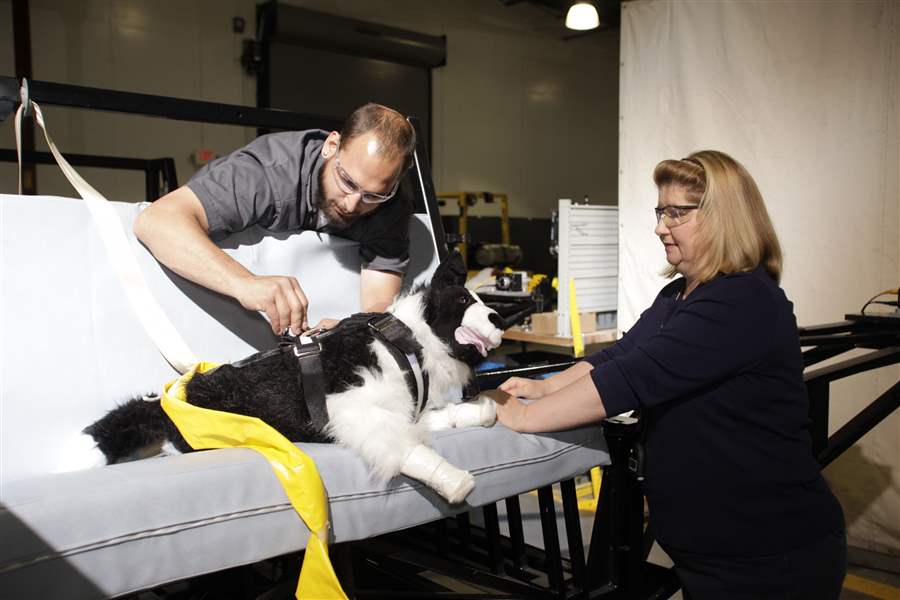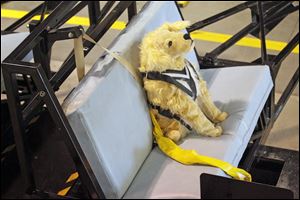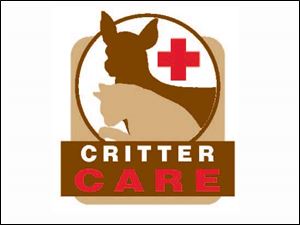
CRITTER CARE
Pet owners should give car safety extra thought
Harnesses protect more than leashes, crates
10/14/2013
Test technician Dan Elwing and Lindsey Wolko, founder of the Center for Pet Safety, prep a crash-test dog that’s been specially weighted and instrumented.

Test technician Dan Elwing and Lindsey Wolko, founder of the Center for Pet Safety, prep a crash-test dog that’s been specially weighted and instrumented.
When traveling by car with your dog or cat, there are two things to consider: Your safety and the safety of your pet.
Dogs bouncing around the car is distracting and can cause an accident, said Dr. Robert Esplin, a Sylvania veterinarian. And if there is an accident, a loose dog’s chances of survival are not good.
“We cared for a dog that went through the windshield,” Dr. Esplin said. “He didn’t survive the trauma.”
Transporting a dog in the bed of a truck is “a really bad idea,” he said. Letting a dog ride with its head out the window also is not smart, Dr. Esplin added.
Dogs can end up with eye injuries or can jump out of car windows or pickup truck beds while the vehicle is in motion, he said.
So what is safe? Many pet owners use harnesses to secure their pet in the seat or put them in a plastic or wire crate. While both of these methods help in preventing distracted driving, in the case of an accident, the pets are not necessarily protected, said Lindsey Wolko, founder and chairman of the Center for Pet Safety, based in Reston, Va.
Ms. Wolko began testing the effectiveness of pet harnesses in 2011 after an incident when her dog Maggie, an English Cocker Spaniel, was harnessed in the backseat and ended up being “hog-tied” by the harness.
“When I slammed on the brakes to avoid an accident, Maggie was thrown into the back of the front seat,” Ms. Wolko said. “She was screaming and I couldn’t get to her fast enough. She was injured and scared, and her safety harness did nothing to protect her. I am still haunted by the sound of her screaming.”

Many pet owners use harnesses as a car-safety restraint. But the type and brand of harness are important, safety advocates say.
The Center for Pet Safety has conducted two studies on harnesses and the results are surprising. The manufacturers’ claims that the products keep pet safe were not validated except in the case of one product, the SleepyPod Clickit Utility harness, she said.
That brand’s three-point connection prevents the launch and subsequent rotation of the test dog, which improves human occupant safety and provides the dog the best possible chance of survival in the case of an accident, Ms. Wolko said.
With tens of millions of dogs traveling with their families every year, the use of pet travel safety restraints is at an all-time high, she said.
“Safety advocates, travel associations, and now law enforcement agencies are recommending or mandating the use of pet safety restraints,” Ms. Wolko said.
However, there are no set standards when it comes to such restraints, so there aren’t criteria by which to evaluate their success or failure, she said.
“It’s so counterintuitive,” Ms. Wolko said. “Some test the buckles, some test strap strength. There’s no consistency.”
Ms. Wolko’s organization and Subaru of America formed a partnership this year to further the center’s 2011 “Harness Crashworthiness Pilot Study.” Seventy percent of Subaru owners own pets, she said.
“We learned in the 2011 pilot study that you want a product that will keep your pet on the seat during the entire period of testing,” she said.
First, 11 brands of harnesses were put through preliminary strength tests. Seven of the brands graduated to the next round of testing, which include testing three sizes of each product using fake stuffed dogs.
“It is important for pet parents to remain vigilant and understand that a strong harness is good. However, a strong harness that prevents your dog from launching off of the seat and controls the movement of the dog is going to offer substantial protection to all family members,” Ms. Wolko said.

The Sleepypod harness was the only one that kept the dog on the seat for the entirety of the test, she said.
The center is raising funds in hopes of doing a similar study of pet crates, which are not as safe as pet owners may think.
“Plastic can shatter on impact, especially if it has become brittle over time and exposure to sun and hot/cold cycles,” she said.
Crates can become projectile objects and hit human passengers, she added.
The first step to keeping pets safe in vehicles is for owners to consider what might happen to their pet in the event of a collision or panic stop.
“This is very much an awareness program,” Ms. Wolko said. “Pet owners in general do not even think to put a harness on their pet or secure them in any way.”
When using a tether, consumers should look for the shortest tether length possible, she said.
“We are working to re-educate consumers to rein in their dogs during travel,” Ms. Wolko said. “Long extension tethers increase the risks to both consumers and their pets. We are also advising consumers to forgo the add-on products like extension tethers and zipline-style products because these add-on devices are likely not tested.”
Other tips Ms. Wolko gives for people who travel with their pets include making sure they are microchipped and have on ID tags in case they end up thrown out of the vehicle during an accident.
While pets might prefer cuddling with passengers or drivers, keeping a pet safe is more important than their need for attention and affection, Dr. Esplin adds.
“Young kids don’t think car seats are real comfortable, but they get used to them, as they don’t know the alternative,” he said. “The same goes for dogs.”
Contact Tanya Irwin at: tirwin@theblade.com, 419-724-6066, or on Twitter @TanyaIrwin.